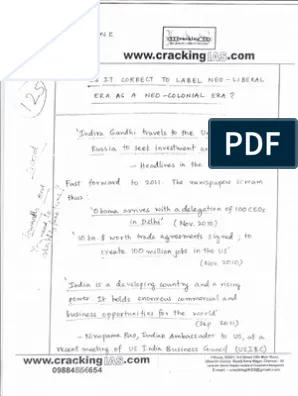- Home
- Prelims
- Mains
- Current Affairs
- Study Materials
- Test Series
 EDITORIALS & ARTICLES
EDITORIALS & ARTICLES
New Industrial Policy 1991
The industrial policy is a series of standards and measures implemented by the government to track the development of industries and related sectors to promote India’s economic growth and development. The New Industrial Policy, of 1991 had the main objective of providing facilities to market forces and increasing efficiency.
- The bigger roles were played by:
- L – Liberalization (Reduction in Government Control)
- P – Privatization (Increasing the Private Sector''s Role & Scope)
- G – Globalisation (Economic Integration between India and the rest of the world)
- The government undertook it to take measures to improve the competitiveness and capabilities of various industries.
- The government undertook various measures to boost the growth of industries such as it allowed domestic firms to import better technology to improve efficiency and to have access to better technology.
- The Foreign Direct Investment ceiling was increased from 40% to 51% in specific sectors.
Need for New Industrial Policy in 1991
India was forced to implement a New Industrial Policy in 1991, including privatization, liberalization, and globalization for the following reasons:
- Mounting Fiscal Deficit: As our planned economy developed, expected spending constantly exceeded expected revenue, leading to a growing fiscal deficit. Compared to 5% in 1981–1982, it climbed to 8.5% of GDP in 1991.
- The government has to undertake interest-bearing public borrowings to cover this shortfall.
- Adverse Balance of Payment: A deficit in the balance of payments occurs when foreign payments exceed foreign receipts. It increased from Rs. 2214 crores in India in 1980–81 to Rs. 17367 crores in 1990–91.
- Thus, the government was forced to borrow money from outside to cover this deficit.
- Gulf Crisis: The Gulf Crisis refers to the 1990–1991 Iran–Iraq war. The result was a dramatic increase in petrol prices in the global market. Despite a dramatic decline in exports to Gulf countries, import costs increased significantly.
- The status of the balance of payments became much more severe. The government was obligated to announce the new industrial plan at this time.
- Fall in Foreign Reserves: Foreign exchange reserves briefly dipped to a level of 2400 crores in 1990–1991; at that time, there was just enough money to cover three weeks'' worth of imports.
- Due to the severity of the situation, Chandra Shekhar''s government was forced to mortgage its gold reserves to pay off the interest and international debts.
- India was compelled to implement a fresh set of policies to build up its foreign exchange reserves.
- Rise in Prices: When the inflation rate increased from 6.7% to 16.7%, the situation deteriorated significantly.
- From 1951 to 1991, the Government of India greatly enlarged the public sector, yet the results were insignificant. So, moving it to the private sector from the public sector was necessary.
Objectives of New Industrial Policy 1991
- Removal of regulations such as licenses and controls.
- Providing assistance to the small-scale sector.
- Increasing the competitive culture among industries to benefit the general public.
- Providing extra incentives to underserved areas and their residents.
- To keep up with the industrialized countries, industrial development must move quickly.
- To free the economy from various government limitations.
- To allow the private sector to operate independently.
- To increase exports while liberalizing imports.
- to increase job opportunities
- Economic liberalization
Features of New Industrial Policy 1991
- Reduction in Government’s Monopoly: Government monopoly was reduced by decreasing the number of industries reserved for the public sector from 17 (as per 1956 policy) to 8 industries such as arms and ammunition, atomic energy, coal, mineral oil, mining of iron ore, manganese ore, gold, silver, mining of copper, lead, etc.
- Abolition of Industrial Licensing: The Industrial Licensing Policy abolished the industrial licensing given to all industries except for the 18 industries, which was further reduced to 6 industries in 1999. These included drugs and pharmaceuticals, hazardous chemicals, explosives such as gunpowder, detonating fuses, etc.
- Provision of Foreign Companies as a Major Stake: It allowed foreign companies to have a majority stake in India. For example, in 47 high-priority industries, up to 51% of FDI was allowed.
- Provision to Non-Residential Indians (NRIs): Non-Resident Indians (NRIs) were allowed 100% equity investments on a non-repatriation basis in all activities except the negative list.
- Internal Agreements on Foreign Technologies: Various international agreements were made about foreign technologies. For example, permitting high-priority industries up to a lump sum payment of Rs. 1 crore, with 5% royalty for domestic sales and 8% for exports.
- Restructuring of Portfolio of Public Sector Investments: Restructuring the portfolio of public sector investments, for example, the PSUs that were unlikely to be turned around were to be referred to the Board for Industrial and Financial Reconstruction (BIFR).
- Removal of Prior Approval from Central Government: To remove the requirement of prior approval of the Central Government for the establishment of new undertakings, expansion of undertakings, merger, amalgamation, etc MRTP act was to be amended.
- Changes in the Standard for Small Units: The criteria for a tiny unit was changed to a unit having an investment limit of Less than Rs. 5 Lakh.
- Establishment of National Renewal Fund: As per this policy, the government announced the establishment of a National Renewal Fund (NRF) to ensure a social safety net for labor.
Impact of New Industrial Policy 1991
- Removal of Restrictions Regarding License, Permit, and Quota Raj: It removed the restrictions experienced during the license, permit, and quota raj. It intended to liberalize the economy by removing bureaucratic restrictions on industrial growth.
- Public Sector’s Role and Disinvestment: The role of the public sector was decreased and two sectors were reserved for the public. The process of disinvestment was started in PSUs.
- Entry of Multi-National Companies: By removing restrictions it enabled the entry of multinational companies, privatization, removal of asset limits on MRTP companies, liberal licensing policy, etc.
- Increment in Domestic and Foreign Investment: Domestic, as well as foreign investment, increased in almost every sector of the economy.
- Increment in Exports and Related Activities: Increased efforts were undertaken to increase exports such as Export Oriented Units (EOU), Export Processing Zones (EPZ), Agri-Export Zones (AEZ), etc emerged.
- Establishment of a Separate Ministry: To better resolve the issues of MSMEs, in 2006, a new act and separate ministry were established.
The New Industrial Policy of 1991 marked a transformative era for India''s economic landscape. Aimed at empowering market forces and enhancing efficiency, the policy addressed the challenges in the country''s industrial structure accumulated over decades. The focus on liberalization, privatization, and globalization ushered in significant changes, reducing government monopoly, abolishing industrial licensing, and attracting foreign investment. The impact was profound, fostering increased domestic and foreign investment, boosting exports, and restructuring the public sector. The policy''s legacy continues to shape India''s economic trajectory, contributing to its growth and development.









 Latest News
Latest News General Studies
General Studies